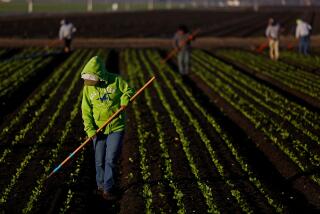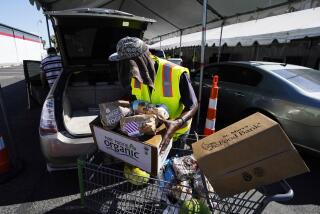93,000 Medium-Size Farms in Financial Trouble, Report Says
- Share via
WASHINGTON — An unpublished Agriculture Department report says that 93,000 mid-size U.S. farms, owing $47 billion, are technically insolvent or on the verge of going broke--a 45% increase from earlier figures.
The figure, amounting to 13.7% of the farms that form the backbone of U.S. commercial agriculture, is considerably more than the 4% rate cited last week by President Reagan when he vetoed legislation intended to provide emergency credit to farmers.
Reagan had said: “The truth of the matter is, in need of immediate help are less than 4%, or around 4% at best, of all the farmers in the United States.” Agriculture Secretary John R. Block, when questioned later about the President’s statement, said that Reagan “misspoke” and that the figure was closer to 10%.
A Worsening Picture
The new report by the department’s Economic Research Service, circulating on Capitol Hill, reiterates data issued several months ago indicating that about 386,000 of the 2.3 million U.S. farms--or nearly 18%--are likely to be suffering some financial stress.
But it goes beyond those numbers to paint a worsening picture for the 679,000 farms that are the mainstream of production agriculture, the so-called “family farms” grossing between $50,000 and $500,000 a year.
“If the situation in early 1984 is extended to early 1985, the available data suggests that one-third of all family-size commercial farms, owing almost one-half of all farm debt, will have some degree of financial difficulty,” the report said.
In January, 1984, an estimated 64,000 farms owing $30 billion in debt had debt-to-asset ratios in excess of 70%, meaning that they were insolvent or “rapidly moving toward insolvency.” That represented about 11% of all mid-size farms.
Increase to 93,000
By early this year, the number in that category had increased to 93,000 farms owing $47 billion of the nation’s $214-billion total agricultural debt. Of those, 43,000 owe more than their assets are worth and will be technically insolvent this year.
Farms with 40 cents in debts for each dollar of assets are deemed “highly leveraged” and likely to suffer shortfalls in cash flow. Those with debt-to-asset ratios of 70% or more are “very highly leveraged” and “almost certain” not to have enough left after expenses to make debt payments.
“As many as 136,000 farms, owing 26% of the debt, will have serious financial problems but will be able to survive a few more unfavorable years,” the report noted, referring to farms now in the 40% to 70% range.
It added that “the number of farms with financial stress in 1985 is likely to increase at roughly the same rate as in 1984.”
Origins in Boom Period
The financial problems in rural America have their origins in the 1970s, when booming export grain sales and high inflation pushed up values of both commodities and the land on which they are produced. Many farmers either entered farming or expanded their operations, despite expensive mortgages and operating loans, expecting the trend to continue.
But the boom went bust after land values peaked in 1981, and those who had incurred debt at high interest rates suffered. The squeeze has worsened as land values dropped, commodity prices and export sales remained depressed, and interest rates remained relatively high.
The problems, while not universal, are most acute in the Midwestern Grain Belt.
More to Read
Sign up for Essential California
The most important California stories and recommendations in your inbox every morning.
You may occasionally receive promotional content from the Los Angeles Times.










